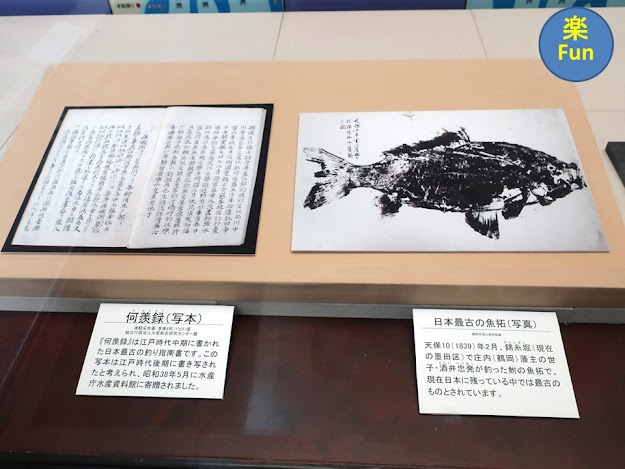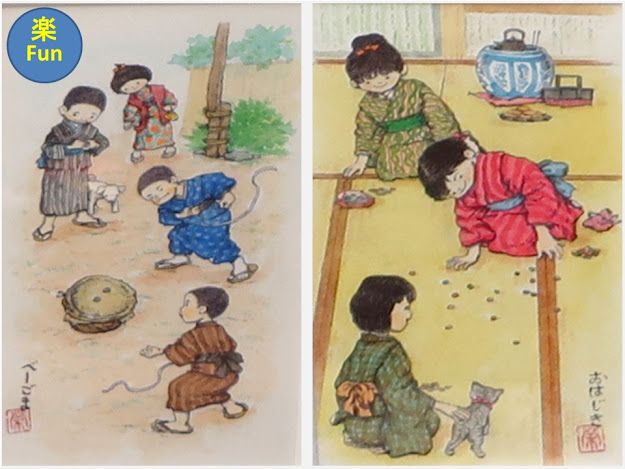This museum was built at the ruin of the checkpoint which controlled the ships from going in and out of Edo (old name of Tokyo). The full-scale building was rebuilt in it. Moreover, we can know the fun of travelers or fishermen who passed here.
On the first floor, we can know about old toys and games of children. It was also good.
There is a rental electric bicycle station in front of the entrance. It’s convenient.
資料館入口には電動自転車のレンタル・ステーションも。ちょっと便利。
江戸への舟の出入りを管理した川の関所・中川船番所の跡に立つ資料館だ。再現された番所があり、その様子が良く分かるだけでなく、川で旅した人、釣りした人など人々が楽しむ様子も伝わってくる。
また、無料の一階のスペースには、昔の子どもたちの遊びの絵やおもちゃが並べてあってこれまた楽しい。
The ruined checkpoint was found in 2005. This building was designed based on the picture of “Edo-meisho-zue” (Edo guidebook).
Samurai officers checked not only passengers but also sake (alcohol) barrels when there was a shortage of rice, which is raw material of it.
Many people of pleasure tours passed here, however they felt
nervous. Their feeling remained as a Senryu poem, “We quit playing the
shamisen guitar and went through.”
Sake barrels on the boat
Spears are prepared. 槍もスタンバイ。
番所が発掘されたのは2005年だという。意外と最近だ。
江戸名所図会に基づいて、番所が再現されている。人のチェックだけで無く、米不足の時は、酒荷物を査検した。
船遊山で通過した庶民も多かったようだが、やはり緊張したようで、「三味線をぱったりやめて通ります」などの川柳が残されている。
Area of Fishing、釣りのコーナー
The manufacturing process of fishing rods are shown in the center and the fishing field of Tokyo Bay which is written in the oldest fishing guide book “Kasenroku” are exhibited on the right.正面が竿作りの工程で、右側が日本最古の釣り指南書・何羨禄に書かれている東京湾の釣り場だ。
Fishing field in Tokyo Bay、東京湾の釣り場
Copy of “Kasenroku” (left) and the photo of the oldest Gyotaku (an ink rubbing of a fish) of a big carp which was fished in 1839 by a son of a daimyo lord.
Gyotaku is the important evidence, especially at the time without photography. I think, there were many Gyotaku before 1839.
何羨禄の写本(左)と日本最古の魚拓の写真。1839年に大名の息子が釣った鮒だ。
魚拓は、カメラがない頃の釣り師の自慢。もっと昔からあるものと思った。
The manufacturing
process of fishing rods、竿の製造工程
Fishing gears. Rods for Haze fish were exhibited. It is aspiring gears probably.
1階の釣り具展示。秋はハゼ釣り竿でした。釣り人垂涎の品なのでしょう。
Rod components for a crucian pole; each piece has its own name. まぶな竿
Nakagawa ship checkpoint in Ukiyoe printing (lower left); there are two ferryboats (lower), three log carriers (middle) and two pleasure fishing boats on the river.
名所江戸百景の中川口。木材を運ぶ筏、舟旅の人、釣り人、様々だ。左下が中川船番所。
Water transportation system、水運
It carried foods, materials and holidaymakers.食糧や資材の物流だけでなく、レジャーにも使われる。
Sake wholeseller by the Shinkawa river (Edo-meisho-zue)
新川酒問屋(江戸名所図会)
”Funa (boat)-Yusan (Pleasure trip)” was popular; people chartered a sightseeing boat at Kioroshi, and visited three shrines, then went to Choshi to enjoy coast cruising.
It was written in the travel diary (1839) that a man enjoyed drinking sake at a liner from Gyotoku (Chiba area) to Nihonbashi (center of Edo) after visiting three shrines. That was a good excursion.
船遊山(味のある言葉ですね)は盛んで、日本橋から行徳までの定期船があっただけでなく、香取・鹿島・息栖の三社詣では人気だったという。
木下(きおろし)河岸から木下茶船で三社を参詣し、更に足を延ばして銚子で磯巡りを楽しんで、木下に戻る貸し切りの遊覧船が就航していた。
1839年3月の道中記には、三社詣でを終えて、行徳から日本橋に行く舟の中で、酒代32文と書いてある。楽しい旅だ。
Steamer run on the river in front of the checkpoint in the Meiji period (1868-1912).
明治に入ると番所の前の小名木川に、蒸気船も走る。
Steamer “Kaiun-maru in 1910
小名木川を進む通運丸(1910年)
The steamer ran around the eastern Kanto area; it was a major transportation system before trains appeared.
明治10年代の蒸気船・通運丸は川を遡って古河や霞ヶ浦まで行っている。白い線が航路。鉄道が発達するまでは、船が主役だった。
Special exhibition “Life and entertainment in the Showa period (1926-1989)”、「昭和の暮らしと遊び」の企画展
Seaweed cultivation、海苔の養殖のコーナー
There were large cultivation fields in
Tokyo Bay in 1960. But the fishery cooperative abandoned the fishing right
because of the development of the industrialization.
1960年の海苔の養殖場。高度成長時代に入っていたと思うが東京湾には沢山の養殖場があった。しかし、工業化が進み、1962年に漁協は漁業権を放棄した。
Seaweed harvesting at Oomori in 1830
大森の海苔の掻き取り
(1830年、東都名所・大森@江戸東京博物館)
Diary of a boy (Tanaka) who was born in 1925
1925年生まれの田中君の日記から
His enjoyable things are written in his diary in 1935 when he was ten.
(1) Playing games outside: kite flying, sumo wrestling, snowball fights, water guns, hide-and-seek, ping-pong, fireworks, sand play, jumping rope, bicycling, baseball, fishing in Suzaki (crab), insect catching (cicadas, dragonflies), swimming in the sea, shooting birds and so on.
(2) Inside play games: playing cards, shogi (chess), military shogi, kendama, book reading and so on.
(3) Favorite book: Shounen (Boy) club
(4) Pet: Japanese dog
(5) Playgrounds: Tomioka Shrine, Fukagawa Fudo temple, Fukagawa park, rivers
(6) Excursions: Asakusa (temple, amusement park), Ginza, Hibiya Park, Science Museum, Kokugikan sports arena, Shibaura, Yasukuni Shrine, Chrysanthemum doll of Tama River, Kairakuen park in Ibaraki, Chichibu mountains in Saitama, Katsuura sea-side town in Chiba, Hakone mountain resort in Kanagawa
It's similar to me around 1970, however, he must have been much
wealthier than I because he went out a lot.
小学四年生の時(1935年)の日記には、
① 外の遊び:凧揚げ、羽根つき、相撲、雪合戦、竹馬、縄跳び、鉄棒、水鉄砲、かくれんぼ、手つなぎ鬼、鬼ごっこ、鞠ぶつけ、ピンポン、花火、砂遊び、縄跳び、自転車、野球、洲崎で魚釣り(かに)、虫取り(セミ、トンボ)、海水浴、鳥を打つ、丸おに、軍艦ゆうぎ
② 家の中での遊び:百人一首、かるた、トランプ、豆かく、将棋、軍人将棋、五目並べ、ぐうちょきぱあ、けん玉、本読み、ローリーゲーム
③ 楽しみにしていた本:少年倶楽部④ ペット:日本犬
⑤ 遊び場:富岡八幡宮、深川不動堂、深川公園、川
⑥ お出かけ:浅草(観音様、花屋敷)、銀座、日比谷公園、科学博物館、国技館、芝浦、靖国神社、多摩川の菊人形、偕楽園、秩父、勝浦、箱根
1970年頃の私の遊び近い。出かけ先が多いので、遠足でなければ、裕福なご家庭ですね。
Board games for boys
男の子用のボードゲーム
Exhibition area on the 1st floor、1階の展示コーナー
Many toys in the Showa period (20th century) and pictures of games in those days are exhibited.昭和のおもちゃと沢山の遊びの絵がありました。
Fighting of spinning tops “Be-goma” (left) and Ohajiki (right)
ベーゴマとおはじき
Chanbara (sword battle) and firefly viewing
チャンバラごっこと蛍狩り
Touryanse game、通りゃんせ
Torpedo and captain game、水雷・艦長
Those are simple and rustic games, I did.
素朴な遊びでした。
There is Kyu-Nakagawa and river park in front of the museum.
資料館の前は旧中川・川の駅という公園になっている。
It was a weekday, but someone enjoyed fishing. It’s nice!
平日だが釣りを楽しんでいる人たちも。
Eight funs(楽fun)were found. Visited in September, 2019
Website: https://www.kcf.or.jp/nakagawa/ (in Japanese), accessed in September, 2020
Previous post (Museum of Haiku poem master near this museum):
Basho memorial museum 芭蕉記念館
Next post (Museum in the busy district in Tokyo):
Shinjuku Historical Museum 新宿歴史博物館
































Comments
Post a Comment